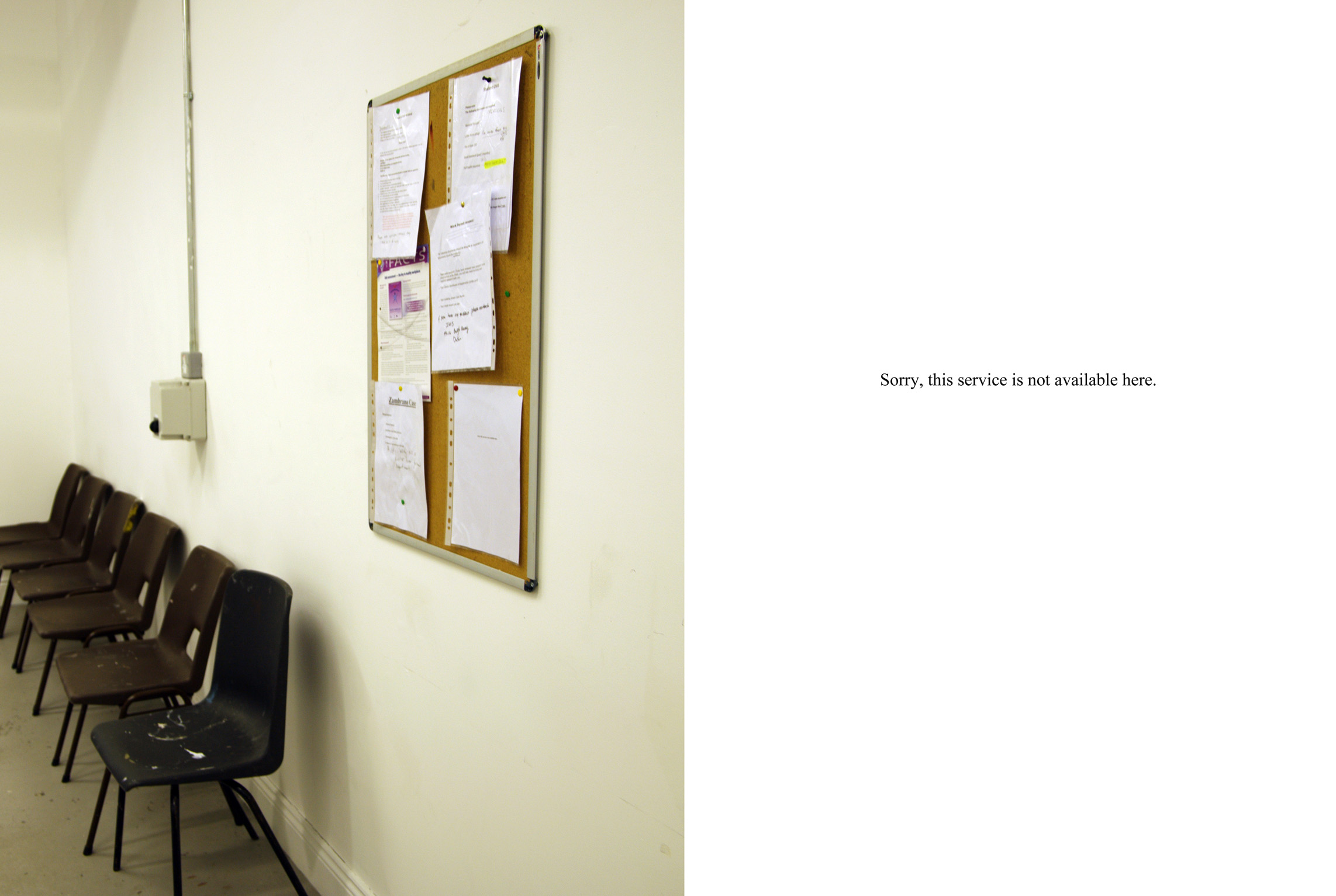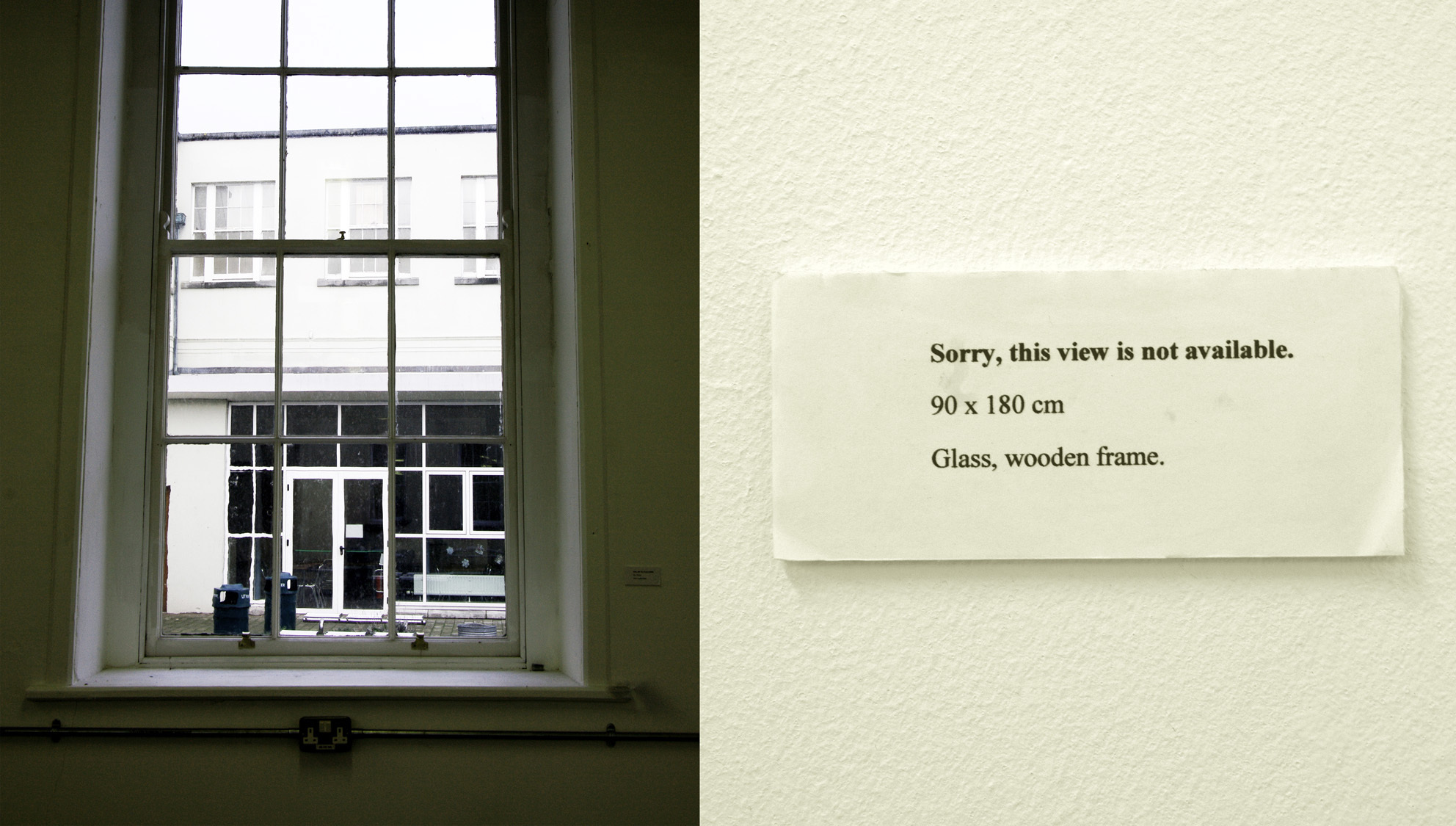Tapahtuma järjestetään Espoon kaupungin sekä Taiteen edistämiskeskuksen tuella.
Kielet: englanti, suomi, venäjä ja ukraina
Työryhmä: Anna Anisimova, lastenkirjailija; Anastasia Artemeva, visuaalinen ja yhteisötaiteilija; Tetiana Makhova, kuvataiteilija; Vera Lapitskaya, tanssitaiteilija
Käsikirja is a multidisciplinary event aimed at children from 4 years old onwards and their adults. The project focuses on exploring the significance of hands in various contexts and through different art disciplines. Participants will engage in activities such as drawing, dancing, crafting, and creating stories to explore the multifaceted role of hands in artistic expression, communication and every day life. Together we’ll also reflect about how we interact with each other, how we can care for and support each other with our hands.
The event is organized with the support of Espoo city and the Arts promotion center Finland.
Languages: English, Finnish, Russian, Ukrainian
Working group: Anna Anisimova, children’s writer; Anastasia Artemeva, visual and socially-engaged artist; Tetiana Makhova, visual artist; Vera Lapitskaya, dance artist
Anastasia Artemeva (b.1989) is a visual and socially-engaged artist based in Helsinki. BA in Sculpture & Combined Media, Limerick School of Art & Design, Ireland (2012), MA Visual Culture & Contemporary Art. She works with textile, text, installation and photography. She is a diversity agent and a certified Dialogue cards facilitator. Anastasia has been teaching workshops for many communities including Children’s Cultural Center Pessi and Tyttöjen Tila in Vantaa, Miesten Asema in Mikkeli, Helsinki prison, Sky and Earth group home in Chiba, Japan. In the past she has received grants from Kone Foundation, the City of Espoo, Arts promotion center Finland, Frame Finland.
Makhova Tetiana was born in 1987 in a small village in the Kherson region. Since childhood, she loved to draw and wanted to become an artist. She loves nature, fairy tales and mythology. This has always been reflected in her creative process. Higher education: - Kherson State University, bachelor's degree: Fine Arts, 2011 & Specialist degree: Fine Arts, Decorative Arts, Artistic Culture, 2012. For ten years after graduation, Makhova worked as a freelance artist, took part in exhibitions and festivals. Married. Mother of three children. During the military invasion in Ukraine on February 24, 2022, she found herself in deep within the occupied territory of Kherson region. After fleeing with her family to Finland, she began the restoration of her creative activity.
Since 2009, Vera Lapitskaya has worked both as an independent dance artist and in collaboration with various artists in Finland and internationally. She has implemented more than twenty dance projects aimed at different target groups. In her works Lapitskaya often combines dance and text, and creates works on the border between dance and theatre. In her artistic work she has been reimagining traditional art forms by pushing the borders and going beyond the surface of narrative meanings.Through the years she has been exploring a multi-layered proximity of human body to space, time, sounds, objects and environment. In her latest works Lapitskaya approached the following themes, among others: human loneliness and togetherness, identity, participation, difference, sameness, tolerance.
Anna Anisimova is a author of more than 13 books for children. She was born in 1983 in the small village Kropotkin in Eastern Siberia and spent her childhood there, among little mountains called «goltsy» and cedar elfin, in a very cold place where people mine gold—her book Kedrovyi Slonik (Cedar Little Elephant) tells about this place. Anna studied at Novosibirsk State University that is located in a Siberian scientific center called Akademgorodok. She is a journalist by diploma specialty. But while studying at the university Anna worked on the creation of newspapers for children and also she worked in the children's camps and created stories with children. Therefore when she started working as a journalist and editor she realized that writing for children is the thing that she like to do the most. So last ten years Anna works as a freelance-writer. Last four years Anna lives in Finland and writes books in Russian and articles about children's literature, participates in the webinars about children's literature, works with Russian-speaking (including bilingual) children as a mentor or writer etc. She was co-host a discussion club "Nevidimyi Slon" (The Invisible Elephant) at the Cultura-säätiö – about reading, books for children and Russian language in Finland. This year she writes a conceptual book "Island-Ferry" about biodiversity in Lauttasaari thanks to Kone Foundation.
Prison Outside
https://prisonspace.org/
Prison Outside is an independent international artistic research project focused on imprisonment, justice, and the role of the arts in the relationships between people in prisons and people outside. We are interested in perceptions of incarcerated persons in society, and how we can break the stereotypes and support them. We focus on artistic practices, be it prisoners’ own initiatives or designed educational projects that promote self-expression, solidarity and communication between people of all walks of life.
Prison Outside was founded in 2015. Since then I have worked with many artistis, communities and institutions, including Helsinki Prison, Esitystaiteen Keskus, Moscow State University of Psychology and Education, and Aalto University to name a few. Since 2017 Prison Outside has been collaborating with Translation Is Dialogue project and its author Arlene Tucker, working together to create the ongoing art exchange and interactive exhibition Free Translation.
----
Prison outside (Vankila ulkona) hanke on keskittynyt vankeuden ja oikeuden teemoihin, sekä taiteen rooliin vankilassa ja vankilan ulkopuolella olevien ihmisten suhteissa. Olemme kiinnostuneet vankien ja ex-vankien käsityksistä sekä havainnoista yhteiskunnasta, ja miten voimme murtaa stereotypioita sekä tukea toisiamme. Keskitymme taiteellisen työskentelyn menetelmiin, niin vankien omiin aloitteisiin kuin suunniteltuihin koulutuksellisiin projekteihinkin, jotka edistävät itseilmaisua, solidaarisuutta ja kommunikaatiota erila
Prison Outside on itsenäinen taide ja tutkimus -projekti, joka on perustettu Helsingissä vuonna 2015 visuaalisen taiteilijan Anastasia Artemevan yhteistyössä paikallisten ja kansainvälisten luovien ammattilaisten, tutkijoiden ja kouluttajien kanssa. Visuaalinen taiteilija ja kasvattaja Arlene Tucker liittyi hankkeeseen vuonna 2017.
Nykyiset projektimme ovat online-alustan Vapaa käännös - Free Translation - ja siihen liittyvät työpajat, blogin Prison Space, jossa kirjoitamme vankeuden ympärillä olevista taiteellisista projekteista, ja Prison Outside kansainvälisiä konferensseja Helsingissä. Olemme tehneet yhteistyötä sellaisten organisaatioiden kanssa, kuten Kriminaalihuollon tukisäätiö, taidekoulu MAA ja Moskovan valtion psykologian ja koulutuksen yliopisto.
---
Независимый научно-творческий проект Тюрьма Снаружи был основан в 2015 году. Он объединяет художников, музыкантов, преподавателей и исследователей. Мы изучаем темы социальной справедливости, лишения свободы, и роль искусства в отношении между людьми в тюрьме и за ее пределами. Объектом исследования являются как практики, инициированные самостоятельно, так и образовательные и культурные программы, которые проводятся организованно. Мы также исследуем отношение общества к заключенным и судимым людям, стигматизацию, и помощь в ре-социализации. С помощью нашей деятельности мы хотим поделиться опытом проведения социально-ангажированных художественных практик в во всем мире.
С 2017 года Prison Outside сотрудничает с проектом Translation Is Dialogue и его автором Арлин Такер, работая вместе над созданием продолжающегося художественного обмена и интерактивной выставки Free Translation.
info(at)prisonspace.org
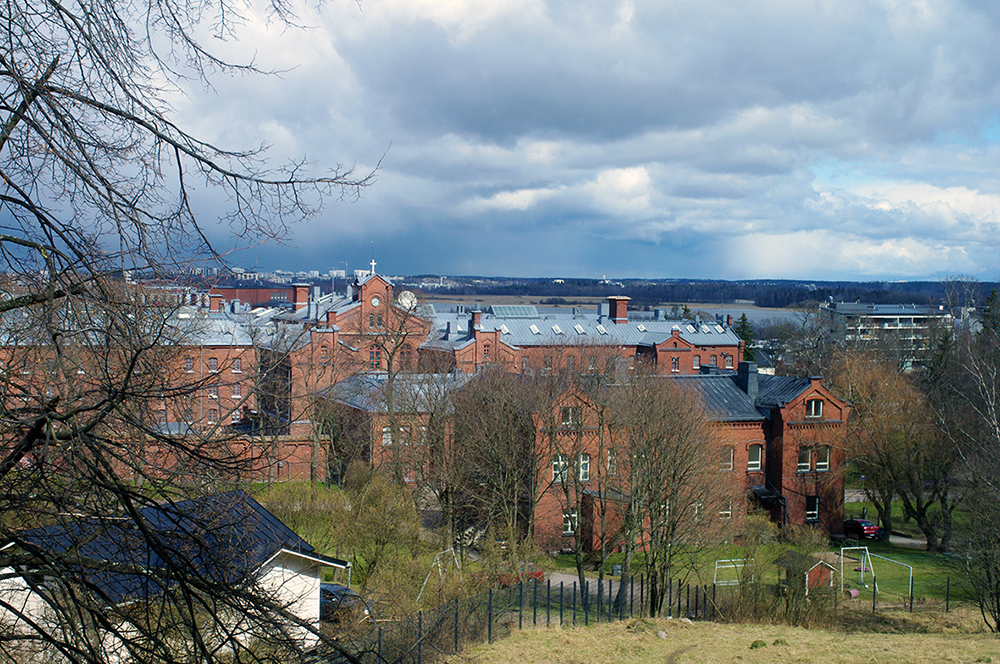
Out first project Invisible Neighbours (Näkkymättömät Naapurit) project took place in September – October 2015, in collaboration with Kalasataman Taidetalkoot community art project of Performance art centre Eskus and Annika Niskanen. The idea was to make a connection between the inmates of Helsinki prison Sörkka and the residents of the nearby blocks of flats. For the duration of six weeks, the two groups made and signed postcards for each other at the meetings held both inside and outside the prison. We talked about our living environments, shared recepies, composed haiku, drew with fresh blueberry juice and made collective self-portraits.

Translation made with Mikhail Agafonov’s group on his visit to correctional facility for young female offenders in Russia. Интерпретация, выполненная на мастер-классе Михаила Агафонова в девичьей воспитательной колонии в России. - Words and Image, 2019
Free Translation is a multi-disciplinary exhibition showcasing international works generated from an open call to incarcerated people, ex-convicts, and anyone affected by imprisonment. It premiered at MAA-tila in Helsinki from November 15-29, 2018 as part of Prison Outside #2, and has since been showcased in Bokvilla, Helsinki and in Moscow State University of Psychology and Educaiton, Moscow, Russia. The exhibition also exists as an interactive online platform.
Free Translation exhibition makes use of the translation process as we interact and create new artworks in the gallery space and online. Your works on view will encourage the audience to prompt dialogue, inspire thoughts, and creatively activate the space. Your voice is heard and recognized.
The call for artworks is ongoing and open to all ages.
Your artistic contribution is very much appreciated. Works can be emailed to info@prisonspace.org or mailed to:
Free Translation
℅ Pixelache
Kaasutehtaankatu 1
00580 Helsinki
Finland
On the online gallery under each picture there is the possibility for you to interpret or comment on that piece. It can be in text, visual, or video format. Your translations and interpretations inspires more thoughts, feelings, and perspectives to be shared and to be sparked.
In our monthly Free Translation Sessions we first view and discuss the artworks of Free Translation exhibition. After our own artworks are created by means of interpretation or translation they are subsequently uploaded to the exhibition website. There they can be viewed by authors and the public, who will be able to create own response. To participate in the meeting, artistic skills are not required, and all materials are provided by the organizers. The “translation” will serve as inspiration for new feelings, thoughts and perspectives, and the creative interactions will continue.
Fabric book workshop - a story you can touch
I use a needle and thread to record our environment and create tactile story books. This project is about the many ways we see the world around us. The fabric sketcbhbooks are designed to record quickly and boldly our environment, or contemplatively and slowly the images in our mind. These books reference guide books of places of local and historical importance.

Mustarinda Residency Open Day - Sew your home, September 2023
I create my own fabric sketches, sell blank fabric books (please click here to browse my online store), and invite participants to various indoor and outdoor textile workshops.
I have held workshops in Finland and in Japan, for groups of people ranging from textile professionals to a group home residents, people age 4 years and up, male and female participants. Depending on the time and interests of the participants, we can create a whole sketchbook from scratch, or we can instead do a series of quick images, using easily-available materials.

Image: Sheung Yiu @sheungyiuphoto - HIAP Suomenlinna Open Studios Spring 2021. Many thanks for support to Iraiida Lukka-de Groot.
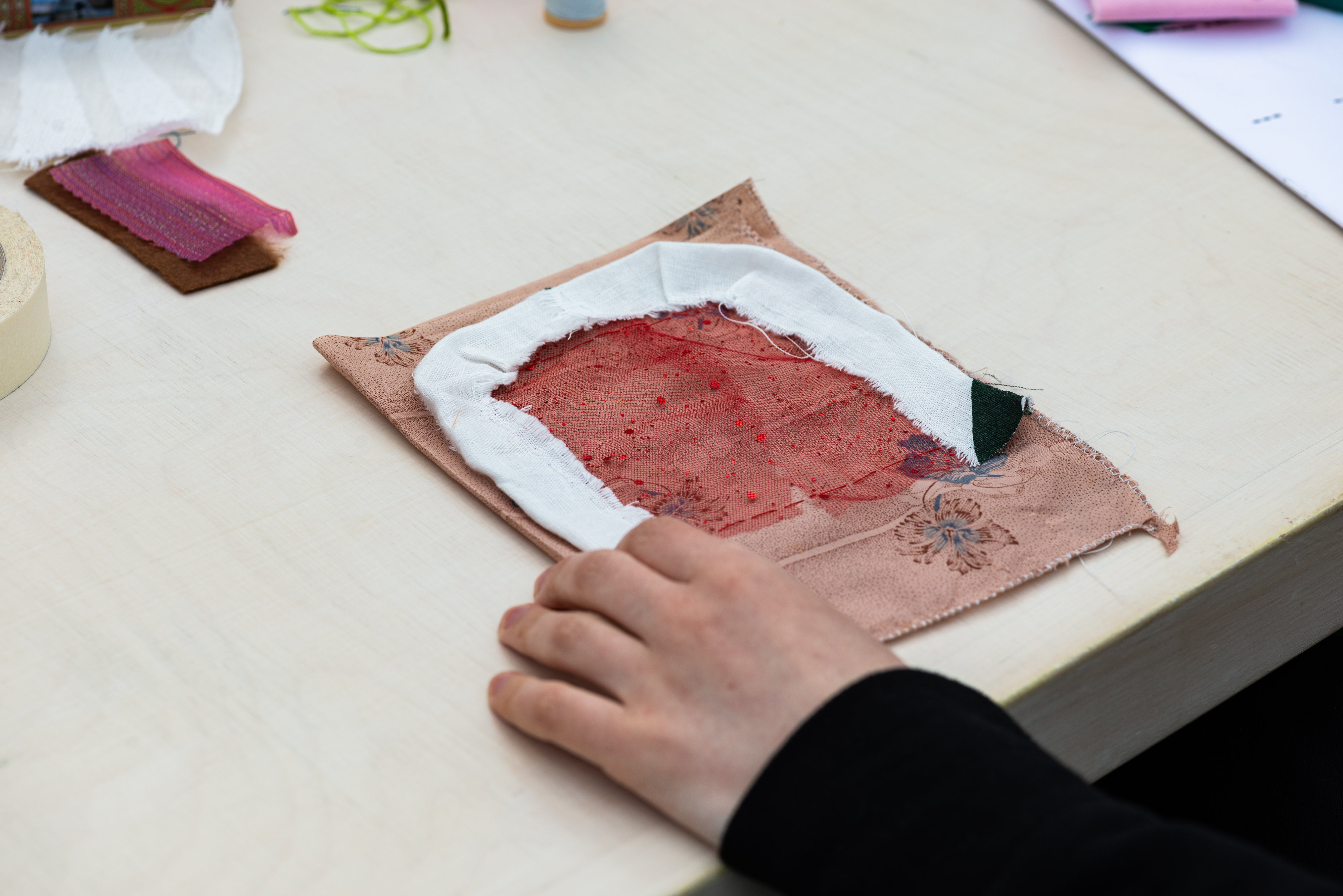 Image: Sheung Yiu @sheungyiuphoto - HIAP Suomenlinna Open Studios Spring 2021. Many thanks for support to Iraiida Lukka-de Groot.
Image: Sheung Yiu @sheungyiuphoto - HIAP Suomenlinna Open Studios Spring 2021. Many thanks for support to Iraiida Lukka-de Groot.In 2023 I travelled to Tokyo on a residency with Tokyo Arts Initiative AIT and with the support of Finnish Cultural Foundation. Japan is heaven for a domesticity admirer like myself. The array of useful domestic paraphernalia like various types of cloths, hooks, nets, packaging material and containers is astonishing. I had picked up several packages of sponges, they appealed to me with their uniformity, squishiness, and colour variety. I had made some experiments with sponges at the Kura house residency, and then decided to invite the workshop participants to play with these everyday materials. We had so much fun!.
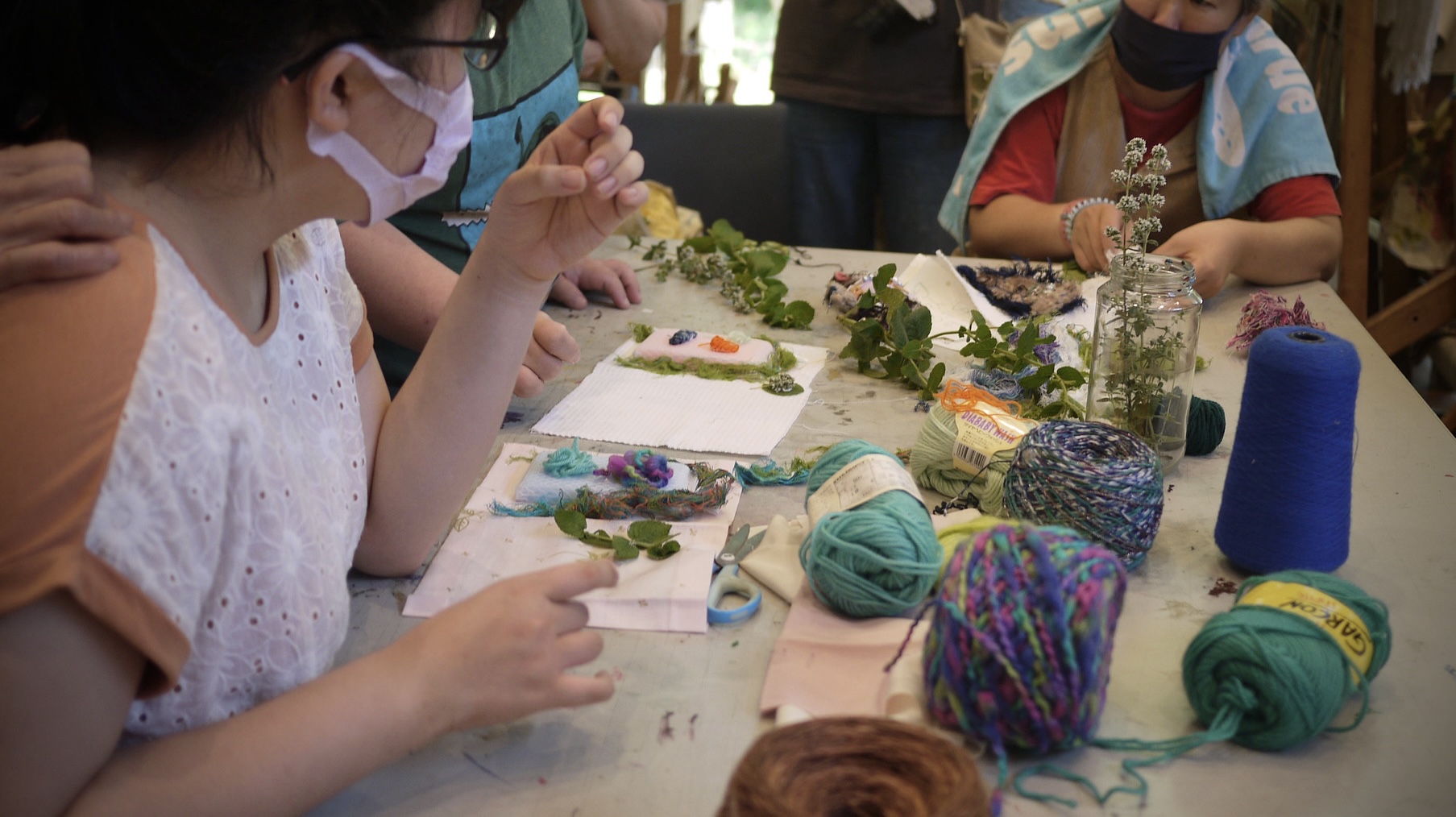 Sora_to_Umi group home & welfare facility, Chiba, Japan, July 4, 2023 Image: AIT
Sora_to_Umi group home & welfare facility, Chiba, Japan, July 4, 2023 Image: AIT
AtelierA, Yoyogi Uehara, Tokyo July 2, 2023 Image: AIT
Mekin pääsimme reissullamme osallistumaan elämykselliseen PISTO-taidetyöpajaan, jonka Seinäjoen Taidehalli järjesti yhdessä Taitokeskuksen kanssa. Taiteilija Anastasia Artemevan ohjaamassa työpajassa pääsimme kokeilemaan tekstiilitaiteen tekemistä itse, kun saimme tehtäväksi luoda kankaisen luonnosvihkon. “Luonnostelu” kankaalle kirjoen on keskittymistä sekä kärsivällisyyttä vaativaa puuhaa: tekeminen on hidasta eikä kuvia voi pyyhkiä kumilla pois, mutta niitä voi halutessaan muokata. On myös kiinnostavaa, kuinka neulalla ja langalla merkintöjä tehdessä syntyy kankaan kääntöpuolelle ikään kuin “haamu” siitä, mitä näemme toisella puolella. Myös tällä kääntöpuolen varjokuvalla on hauska leikitellä. Ihastuin kirjontatöihin työpajan ansiosta ihan valtavasti: työskentely on kiireiselle mielelle ihanan meditatiivista puuhaa. Hurahdin oman luonnosvihkoni väkertämiseen niin antaumuksella, että olen jatkanut sen työstämistä vielä kotiin päästyänikin. Tämä oli todella inspiroiva kokemus!
-Jenni Rotonen, https://pupulandia.fi/2021/06/22/seinajoki-yllattava-kulttuurikohde-kesareissuille/
Kunsthalle Seinäjoki, June 2021
I use these sketchbooks especially when traveling or camping and for this reason I look for ways to create lightweight, compact sets to take with me. I reappropriate old tins and cans and plastic bags, and use camping equipment as tools. I am constantly in the process of developing a kit, a set of materials and tools that I carry with me. The use of a variety of shapes and textures draw from open-ended toys and games for children, including the techniques and the aesthetics of Waldorf toys. Hand dyed using natural materials found at home like coffee and tea and frozen berries and beets leftover from dying Easter eggs. I use recycled materials like leftover fabric and packaging material. The fabrics and other materials that the books are made from allow for them to be washed and ironed.
You are invited to join the workshops where we sketch and explore together.
Image: Anastasia Artemeva. Venäjän tiede- ja kulttuurikeskus, Helsinki, Fabric book workshop with young people, 2017
Mekin pääsimme reissullamme osallistumaan elämykselliseen PISTO-taidetyöpajaan, jonka Seinäjoen Taidehalli järjesti yhdessä Taitokeskuksen kanssa. Taiteilija Anastasia Artemevan ohjaamassa työpajassa pääsimme kokeilemaan tekstiilitaiteen tekemistä itse, kun saimme tehtäväksi luoda kankaisen luonnosvihkon. “Luonnostelu” kankaalle kirjoen on keskittymistä sekä kärsivällisyyttä vaativaa puuhaa: tekeminen on hidasta eikä kuvia voi pyyhkiä kumilla pois, mutta niitä voi halutessaan muokata. On myös kiinnostavaa, kuinka neulalla ja langalla merkintöjä tehdessä syntyy kankaan kääntöpuolelle ikään kuin “haamu” siitä, mitä näemme toisella puolella. Myös tällä kääntöpuolen varjokuvalla on hauska leikitellä. Ihastuin kirjontatöihin työpajan ansiosta ihan valtavasti: työskentely on kiireiselle mielelle ihanan meditatiivista puuhaa. Hurahdin oman luonnosvihkoni väkertämiseen niin antaumuksella, että olen jatkanut sen työstämistä vielä kotiin päästyänikin. Tämä oli todella inspiroiva kokemus!
-Jenni Rotonen, https://pupulandia.fi/2021/06/22/seinajoki-yllattava-kulttuurikohde-kesareissuille/
Fabric books is a part of Recreation is a series of projects and multimedia installations around the act of sewing, the spaces of confinement, rest, and time. Through visual, performative and dialogical processes I will investigate assumed social roles, ideas of judgement, social and antisocial being, as well as personal and collective boundaries.
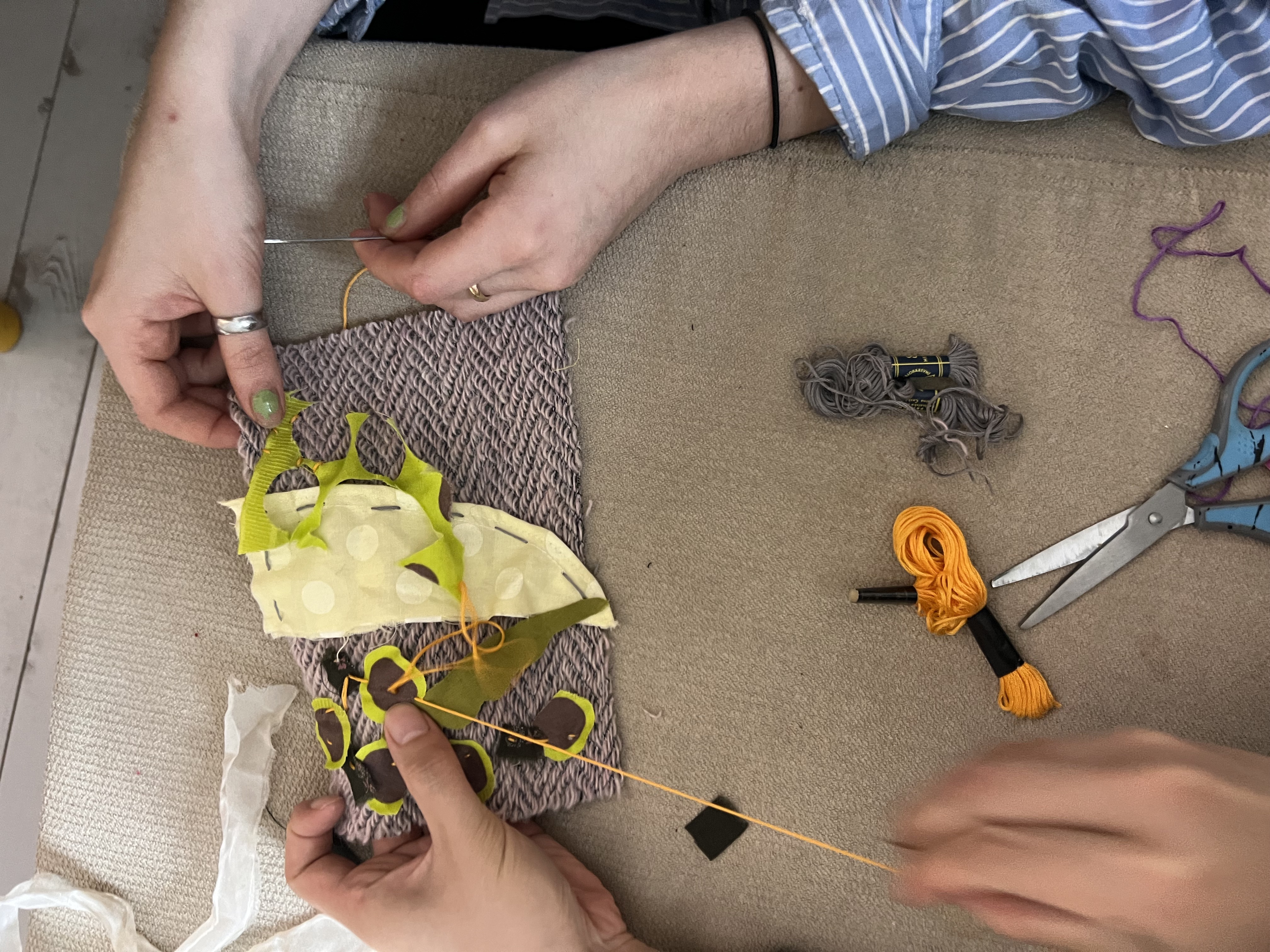
Mustarinda Residency Open Day - Sew your home, September 2023
Mustarinda residency September 2023
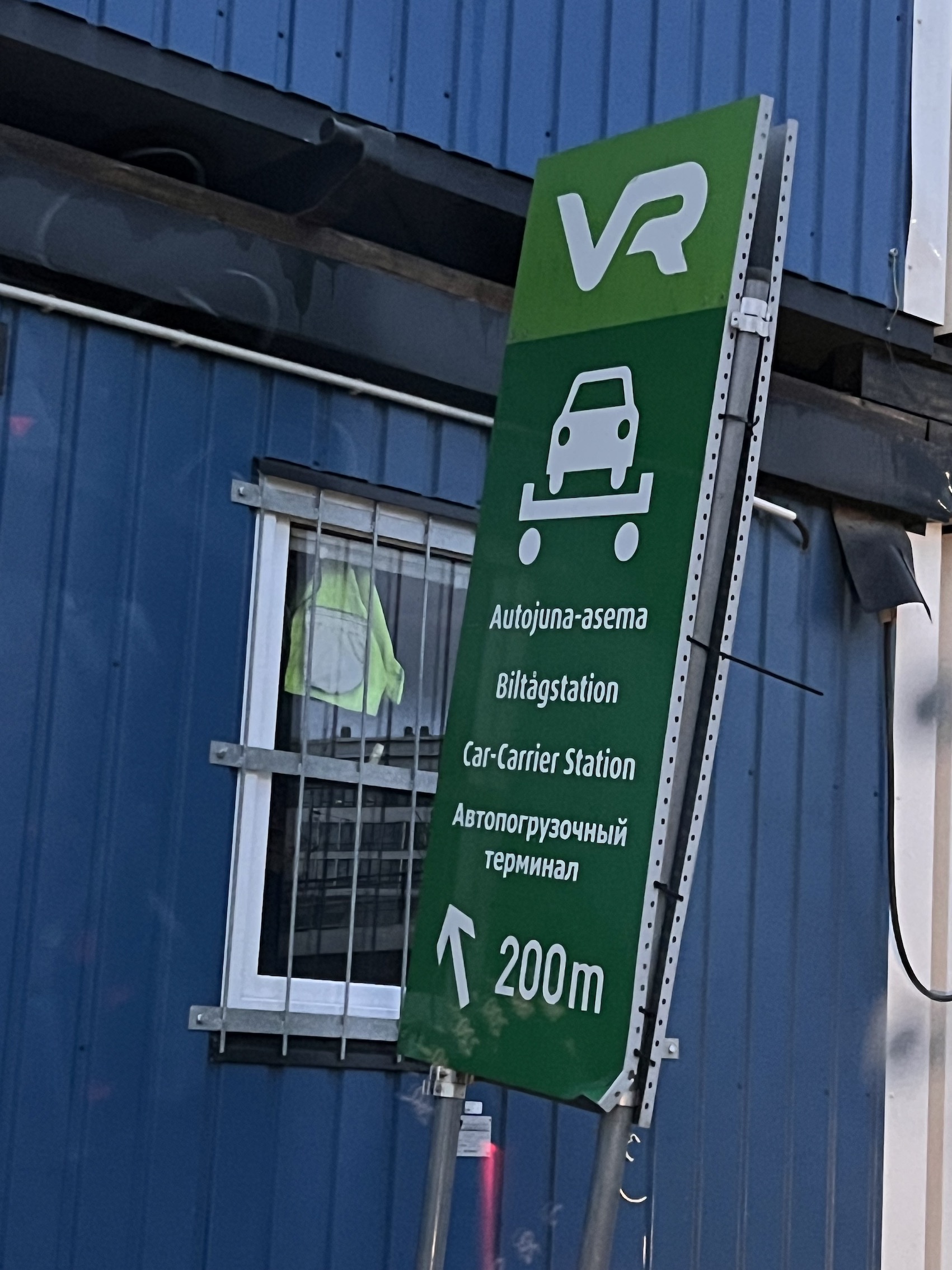
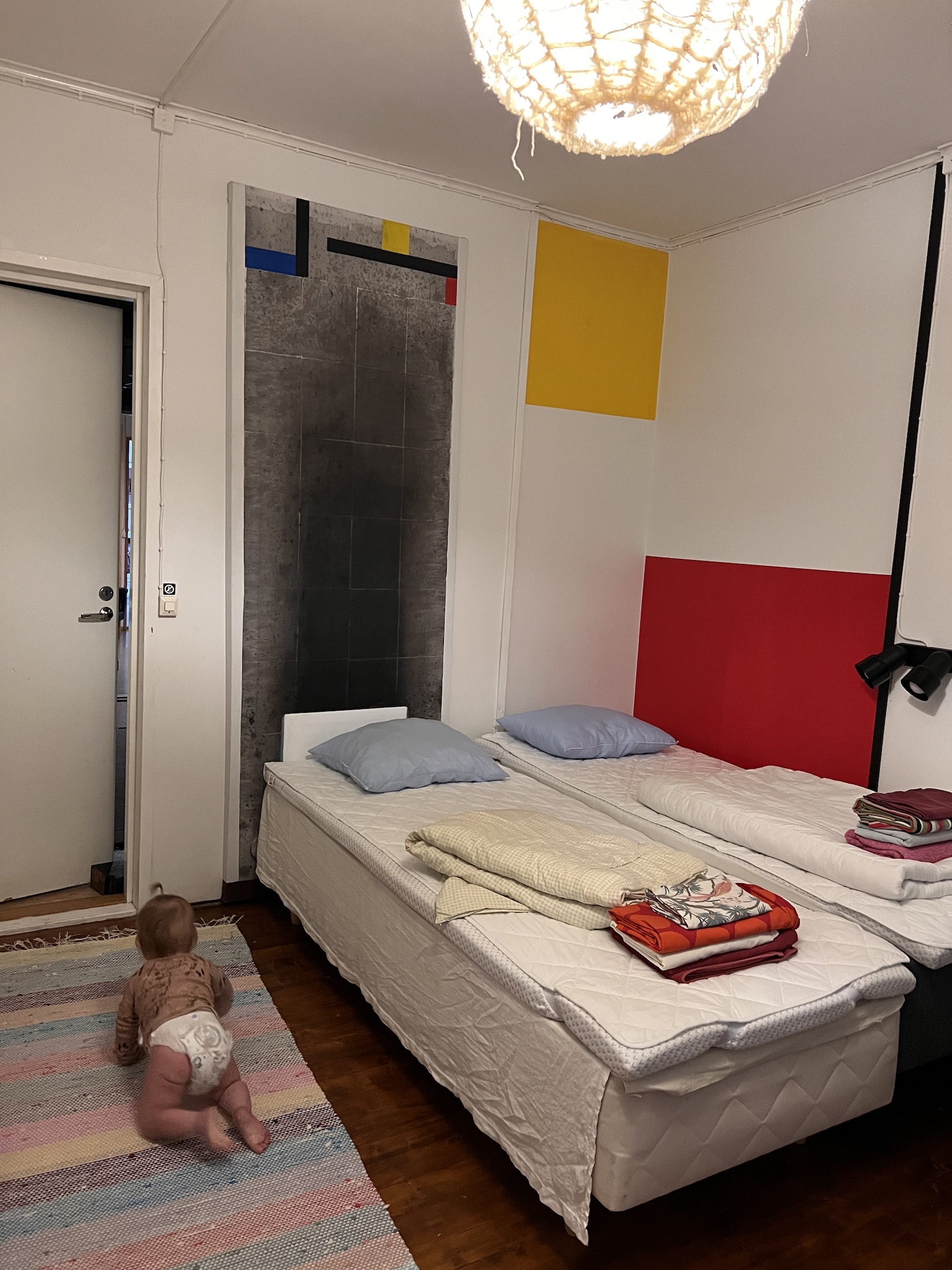

Dear You
Dear You is about making friends around the world through creating and sharing art.
All Dear You participating schools are organized to have a Dear You friend in another country. For example, a class of six year olds in Greenland will be paired with a class of six year olds in Finland. School teachers or hired Dear You workshop leaders living in these countries will go to the schools in their respective location and hold workshops for the children in the school once a month. During these workshops the children will create their art projects, which will then be mailed to their Dear You friends abroad. Dear You focuses on the process of art practice, opening dialogue, and discovering our surroundings!
This concept is similar to having pen friends, but in Dear You every time the students correspond with each other, a new art technique will be introduced. Every participating class will receive an age-appropriate Dear You Art Project, which all the artists will create for each other. The classroom teachers will assist in all these fun and creative things to share- anything that fits in an envelope!
The project is created by Arlene Tucker. Anastasia Artemeva worked with Arlene in this project during the years 2015-2017. Please read more here https://www.dearyouartproject.com/

The 4th graders from Ryerson Public School in Cambridge, Canada making and sharing art with the 10 years olds from Kepa School in Karelia, Russia, 2017.
Here is some of our projects:
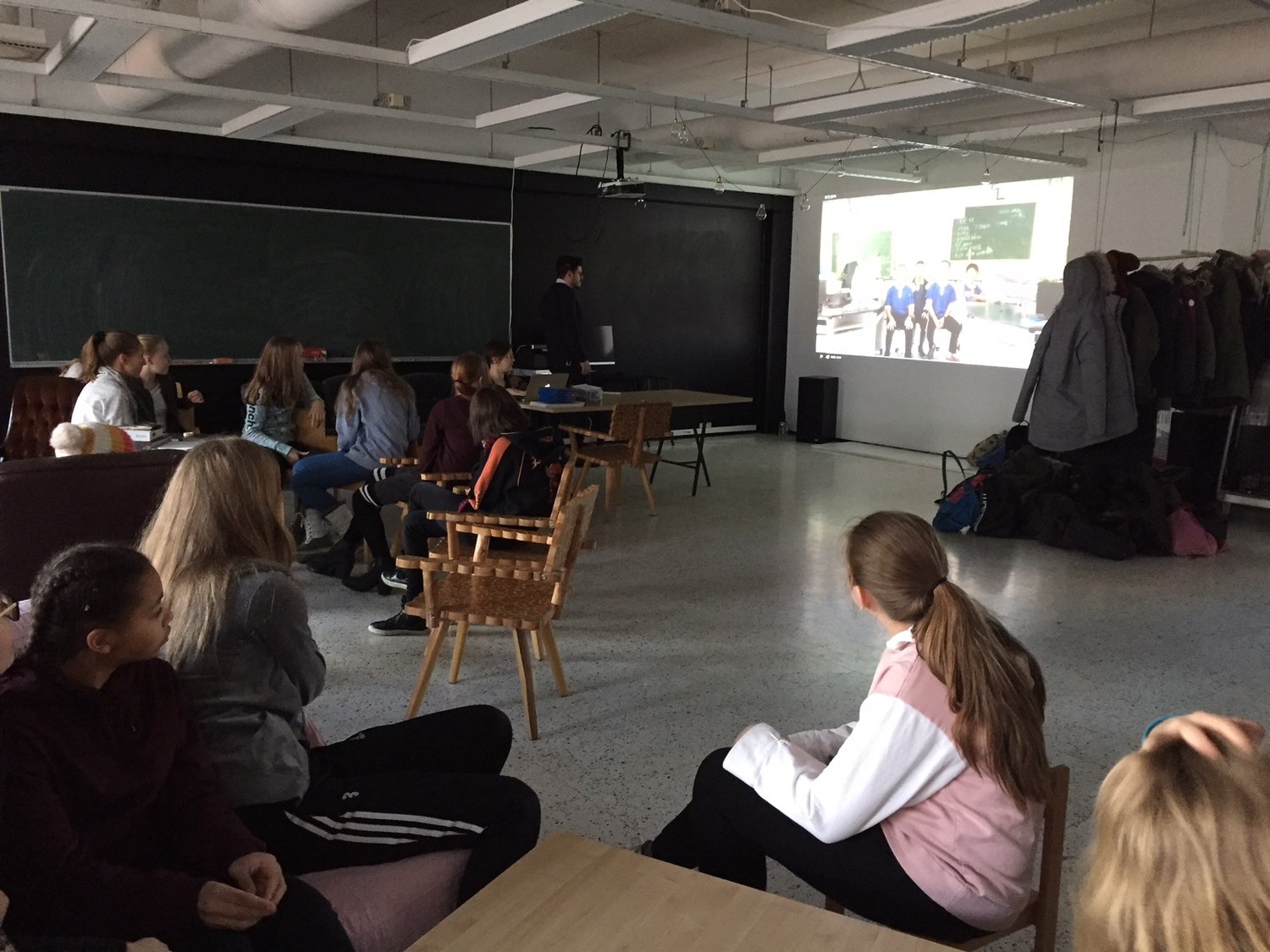
Inspiting Stories, Fall 2017.
We thought it would be great to bring the artists in 7C from Helsingin yhteislyseo to get to know another artistic space in Kontula, Helsinki. So we gathered in Museum of Impossible Forms to create Inspiring Stories art project and celebrate with next year's Dear You group from Päiväkoti Pihapirtti, who are also located in Kontula!
We started the session by looking at a video a few of the artists from Shenzhen Middle School made for their friends in Kontula. They had made a sweet introduction of themselves and also shared with us the art that they have been making in China.
Looking at our friend's artwork and thinking about past Dear You projects we have made gave us some material to work with as the next step was to make an audio story. One artist said we need to keep in mind the sanoma (the message) when creating a story. Some other creative writing elements are to designate characters and what is the beginning, middle, and end of the story.
We then got into small groups and came up with four different amazing stories! When it was time to record, we thought about intonation, sound effects, and tone of voice to enhance the story.
The 13 year old artists at Helsingin yhteislyseo in Helsinki, Finland are making and sharing art with the 13 year old artists from Shenzhen Middle School in Shenzhen, China.
In autumn 2017 Dear You project in Kontula is supported by the Museum of Impossible Forms.

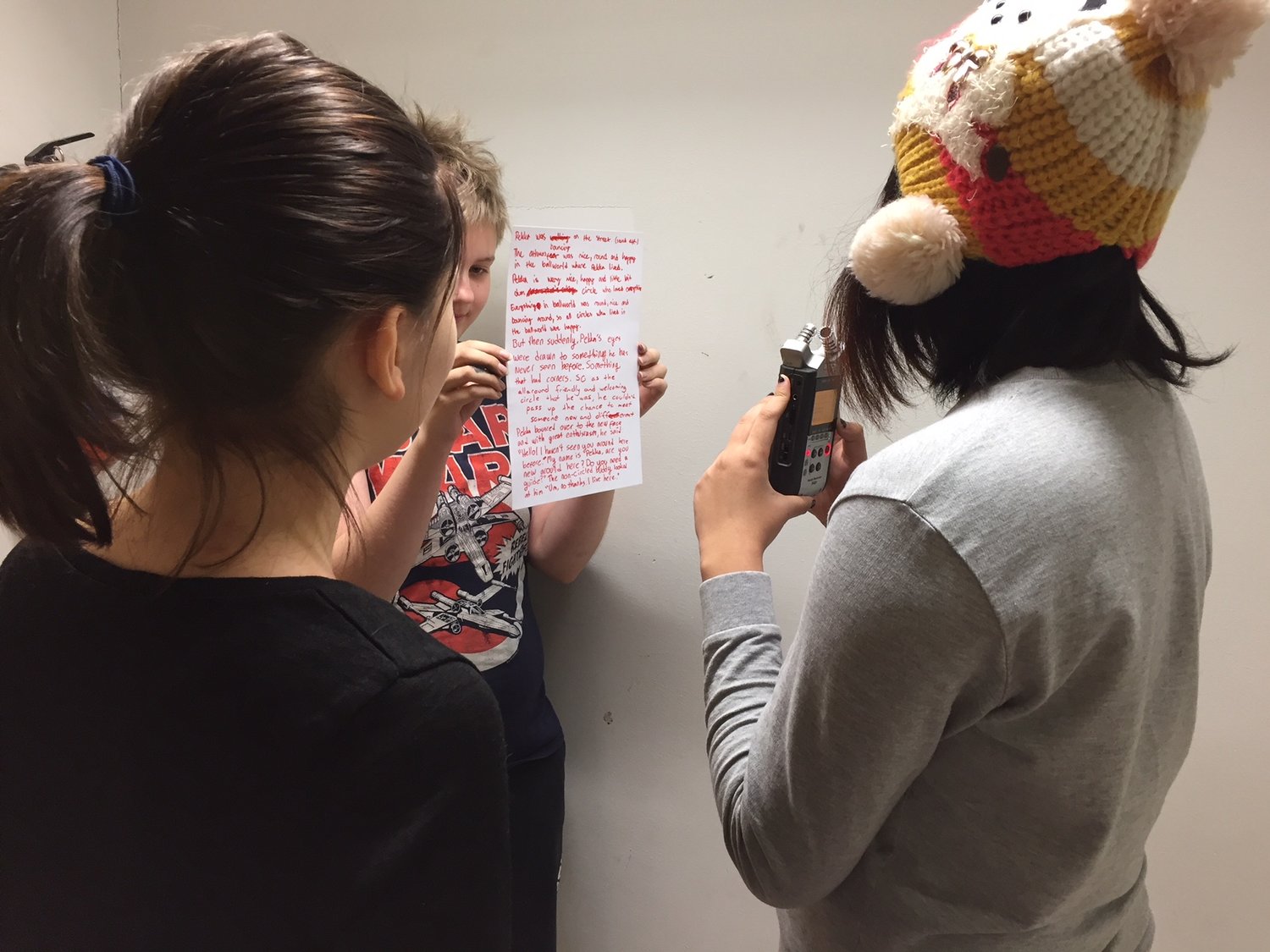

The storytellers from Differences and Similarities have more questions for their friends in China.
Do you pack your own lunch? Or do you pay 1euro for it? Or how much?
Do you have a lot of homework?
When does your school day end?
Are your tests difficult?
Does your school have any after-school activities?
Eläimet puussa , Animal in the tree (English translation)
All the animals are meeting under a tree and they decided to make a pack. The pack leader is the lion. The walrus also wants to be a leader. They start to fight and the walrus wins. The walrus will become the leader and so the lion has to go. The walrus was a good leader but the lion returned. The lion took a coconut from the tree and hit the walrus in the head with it while the walrus was asleep. The walrus got a mild concussion! The lion became the leader again. The animals didn't want the lion to the be leader so everybody else left the pack.
(Orignially posted by Arlene Tucker here )

From left to right: Saara Raevuori, Arlene Tucker, and Anastasia Artemeva. Saara is the art teacher at Helsingin yhteislyseo. Arlene and Anastasia are the makers and creators of Dear You. Thank you, Museum of Impossible Forms for hosting us!

Poikkeustila, Martial Law
2017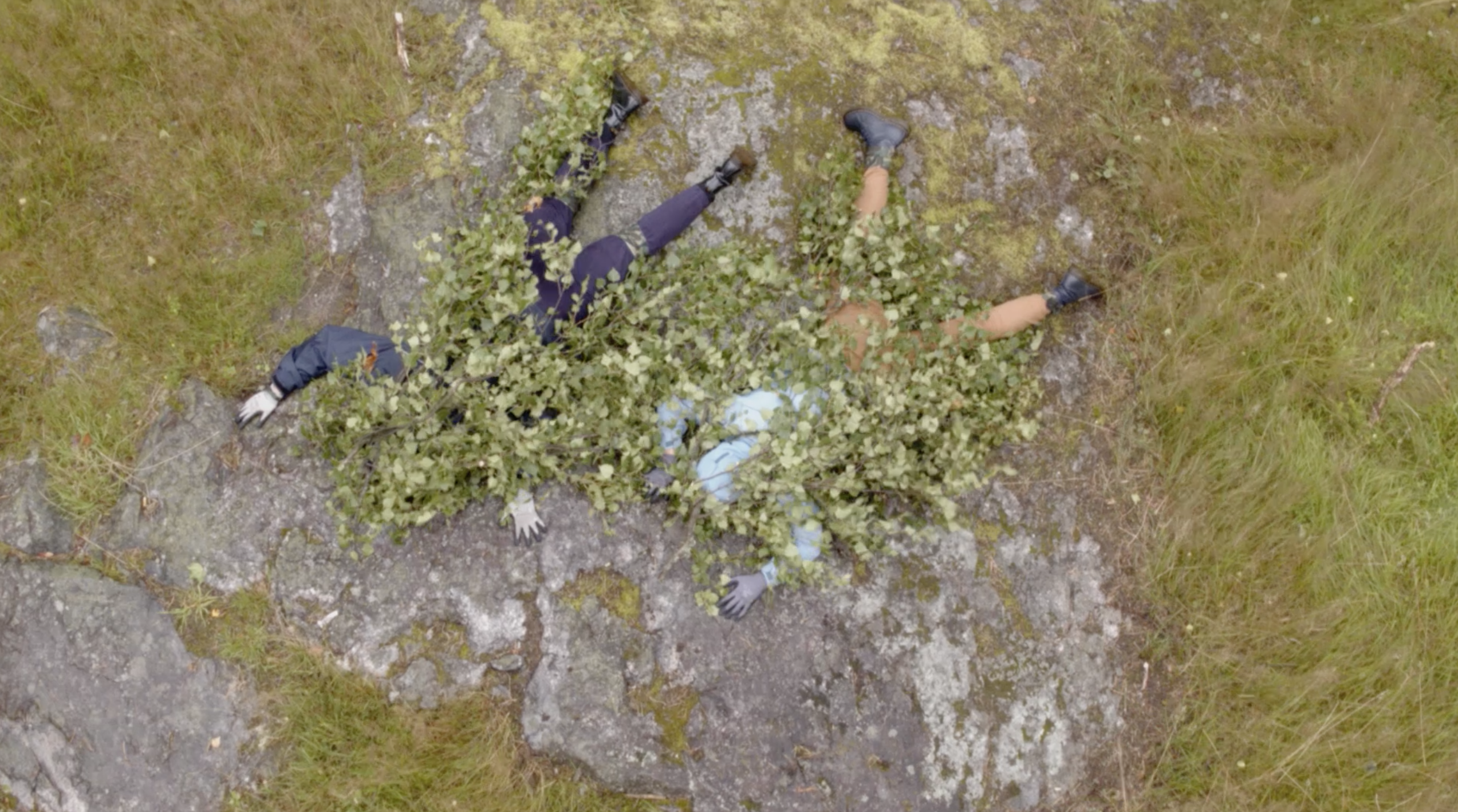
I’ve heard that it was prisoners who built these trenches, for if the war comes to Helsinki. But what prisoners? Where did they come from? Where they Russian or Chinese or Swedish ? Where i lived in Katajanokka there was a prison. Now it’s a hotel, isn’t it?
Collabortiave art project produced by artist Anastsia Artemeva and collaborative media art residency m-cult, about common (his)tory between clients of Kriminaalihuollon tukisäätiö (Krits) and local folks of suburban neighbourhood of Maunula, Helsinki. Krits is an NGO that support people in prison and their families, and through the project Maalinnoitushanke employes men who are currently on probation or are nearing the end of their prison sentence to restore the WWI trenchers around Helsinki.
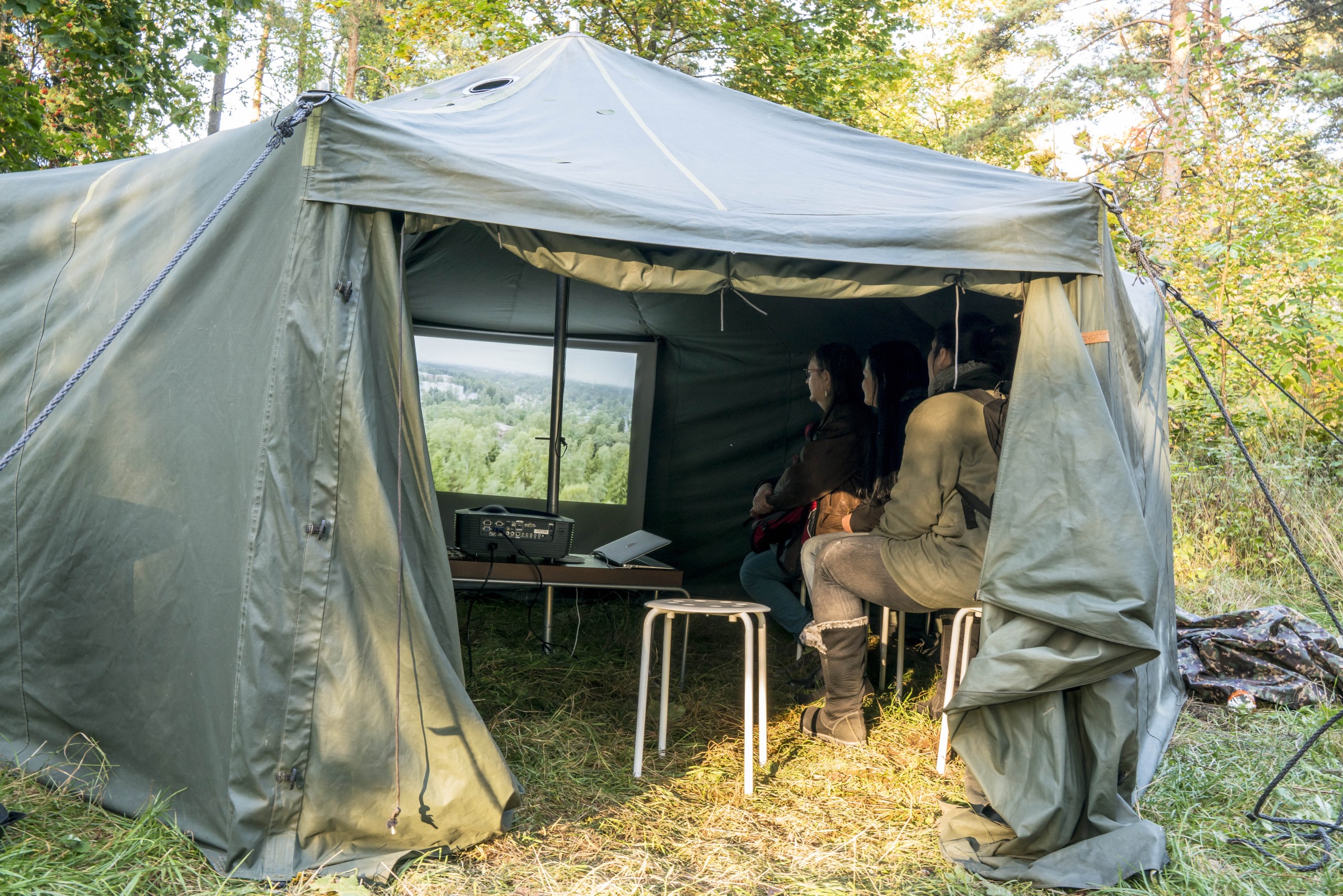
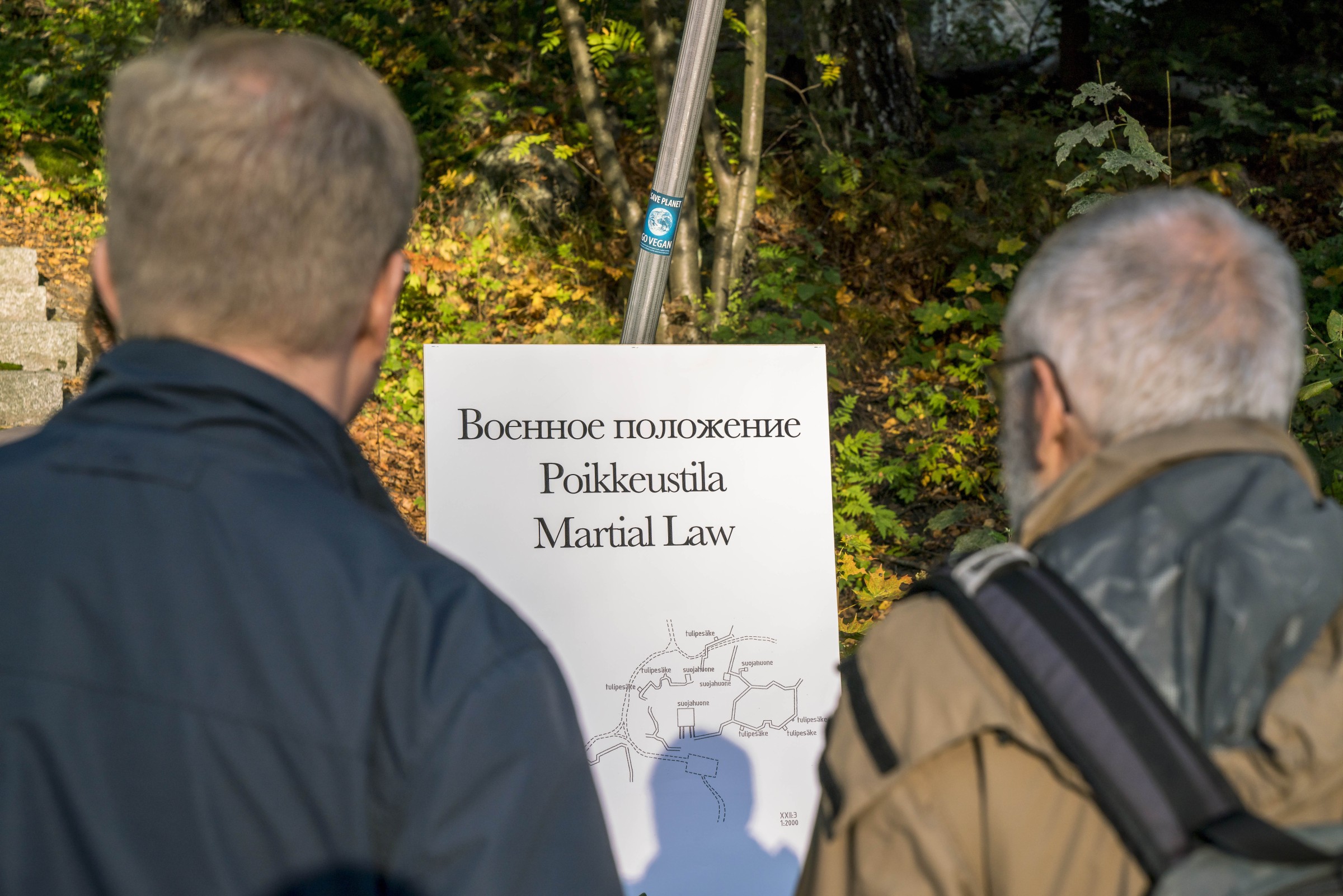
After the Russians left, and the Finnish state announced independence, the government and the people began to take the trenches down and use the valuable materials to build homes. The blew metal roofs off their paces, leaving the bunkers exposed. The Reds attempted to re-appropriate the trenches as hiding places, but the lack of professional soldiers in their groups meant they could not hold for very long.


Photography Vesa-Pekka Grönfors
Under an old house there is a storage room for cannon ammunition, which is still completely intact. There are two rooms, a window between the rooms, rails and concrete walls - all are still in place. The owners use it as a root cellar. They keep preserves there. Raspberry jam mostly.
Screenplay, design: Anastasia Artemeva
Sound design: Johannes Vartola
Voice: Anna Rawlings
Collaborators:
KRITS Maalinnoitushanke
Helander-koti
Suursuon päiväkoti
Maunula-talo
Markku Heikkinen, Helsinki city museum
Production:
Anastasia Artemeva & m-cult / Kaisa Kukkonen, Minna Tarkka

Anastasia Artemeva:
“I found the trenches project (Maalinnoitushanke) to be an excellent idea, as it both takes care of urban environment, and focuses on mental welfare of convicts, and I am very excited to be a guest in it. I see my role to suggest and facilitate a broader engagement with the place. I am also excited to introduce the Trenches project via Martial Law to the people who cannot physically go there to see it, or mentally feel separated from the prison folks due to the stigma attached to incarceration.
I have a particular interest in Patterimäki because it has no obvious famous history. It was built (as the story goes) by Chinese POWs shipped from Siberia to protect the Russian Empire from German invaders. Yet no battles were held, and there is no heroics acknowledged. It is in a way a blank canvas, a space we can project our own ideas of protection, containment, identity.

Based on the wishes and interests of the participants, as well as certain restrictions naturally coming while working with institutions, this collaborative project will employ different media. Personal stories, historical facts and scripted narrative merged through storytelling.
The collaboration turned out to be not only about the actual physical exchange of art works but also exchnage of our life conditions. It has become a lot about restriction, protection and fear. For example, the concept of anonymity that was borrowed from the Krits group and then presented to residents of the old folks’ home, and a dicussion followed as we made masks to hide our own identity. These masks were later worn by children who came to visit the site.”
Please read the full interview in Finnish and learn more about the project here.

Macro Golf
2018
Collaboration with Steve Maher
Meta-description

Deep in the valley of Helsinki, hewn into the very rock itself, lies the ruins of an ancient and mysterious archaeological site. Its true purpose is unknown, however many believe when it was built it signified something of great importance for the valley's inhabitants. The site and its layout bare potentially some sort of geometric or astrological parallel in which a ritual practice was likely performed. It is hypothesised that practitioners and pilgrims alike would traverse a set of challenges laid out within the space in order to prove their worth. The remains of roughly nine monuments can be found on the site, artifacts unearthed in the area have lead theorist to believe that using a short cudgel like object those participating in the ritual would manoeuvre a small circular white object through many perils and pitfalls. The outcome of the ritual we can only speculate, however we can surmise that the pockmarked holes on each monument served as some sort of receptacle for the small yet significant object. This major historical site may lead us to rethink the origins of mankind.
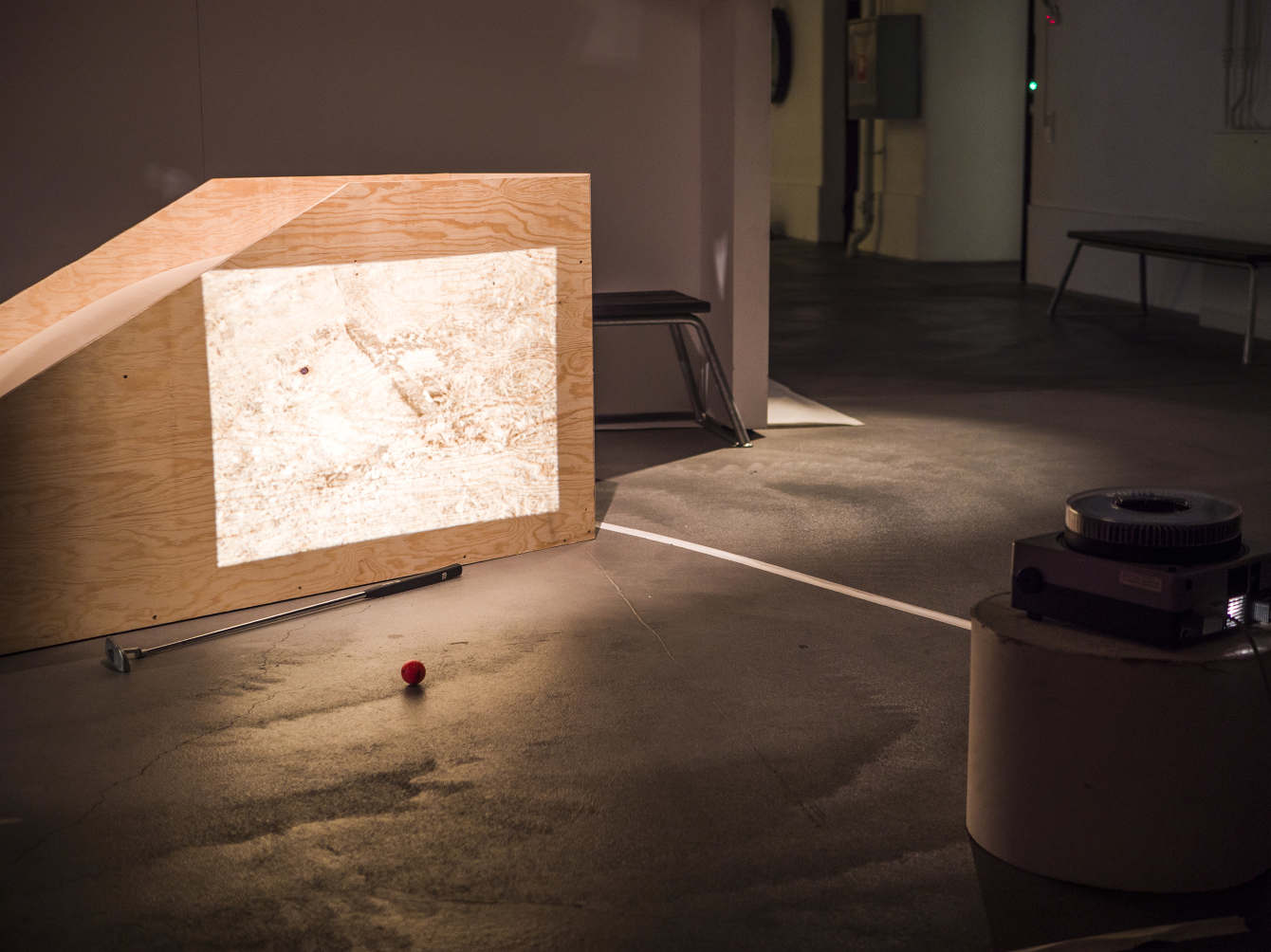
Description
The remains of a mini-golf course, possibly built in the 1950s, lie on the verge of the Helsinki city district of Laakso and its Central park. According to a source in the Helsinki Sanomat it was originally built by the Kristillinen Teekkariyhdistys for the people of the local area. Over the course of almost 70 years the site has fallen into disarray, with the last game of miniature golf likely to have been played there over a generation ago, slowly the forest is reclaiming this site making the delineations of its former purpose seemingly kabbalistic or esoteric.
Through a recreation of a hypothetical interactive miniature golf obstacle within the exhibition space functioning as a backdrop to a video work about the site the artist duo of Artemeva and Maher present a question about our associations with history, camouflage and triviality.
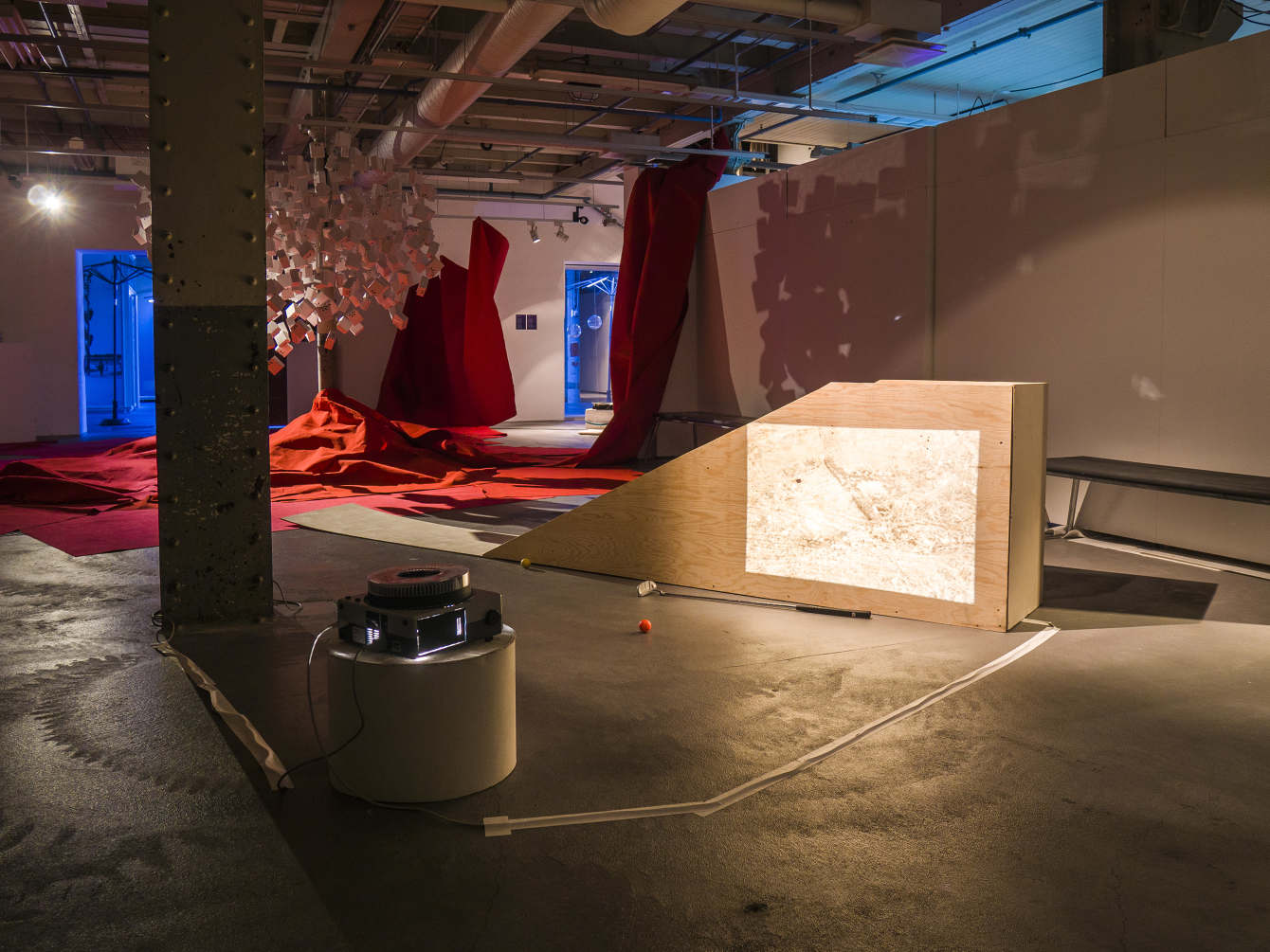
Leviathan
2017Leviathan is a dual show concept by Steve Maher and Anastasia Artemeva, in which the gallery of Oksasenkatu 11 is re-configured as the digestive system of an imagined leviathan, delving deep into the depths of the galleries core, basement level, the audience will be immersed within an artwork installation through the arrangement of lighting, sound, scent, video and objects.
Leviathan takes advantage of Oksasenkatu’s unique gallery layout as a space with basement access, Oksasenkatu 11 is a deceptive space, architecturally it is much larger than initial perceptions.
Throughout literature and mythology the leviathan re-occurs as allegory. In some tales it is a beast of sea, a giant fish or whale. In others it is an organisation, something which underpins the fabric of our world, engulfing it, consuming it, becoming a world itself. From the biblical parable of Jonah to the folk-tale of Pinocchio, the individual consumed into the depth of a beast who must escape or live for the rest of their days struggling against the digestive acids wishing to consume them re-occurs time and time again. Its origins are thought to have come from the oldest known tale, the epic of Gilgamesh.
The reality of being consumed by a giant whale or sea creature is far less fantastic. One is more than likely to succumb to drowning, asphyxiation and the grinding of teeth before one would ever manage to construct a crude shelter within made of shipwrecks and flotsam. There is one supposed case of a “real world Jonah” in the tale of James Bartley although nautical historians have since disproven what clearly began as drunken embellishment. The reality of the cetacean beings which inhabit these planets oceans are not the gigantic monstrosos which litter our mythologies, the reality is incredibly complex social animals who everyday come closer and closer to extinction.
Mikko Niemistö: Birthday
Visual design for a solo performance2017
”Starting from a melancholy party preparation, Birthday transforms into an increasingly intensive one-man revelry…Each object has a specific energy and they have a life of their own: the guitar plays itself, the coffeemaker grumbles rhythmically and the ball of ice tied to a fishing rod melts.” -Maria Säkö, Helsingin Sanomat 24.2.2017
Birthday is a dismantled solo that aims to break down subjectivity and expand agency from the performer to a collection of personal everyday objects and natural materials. The performance becomes a ritualistic creation of worlds and landscapes both within the human body and in the shared space of the performance event.
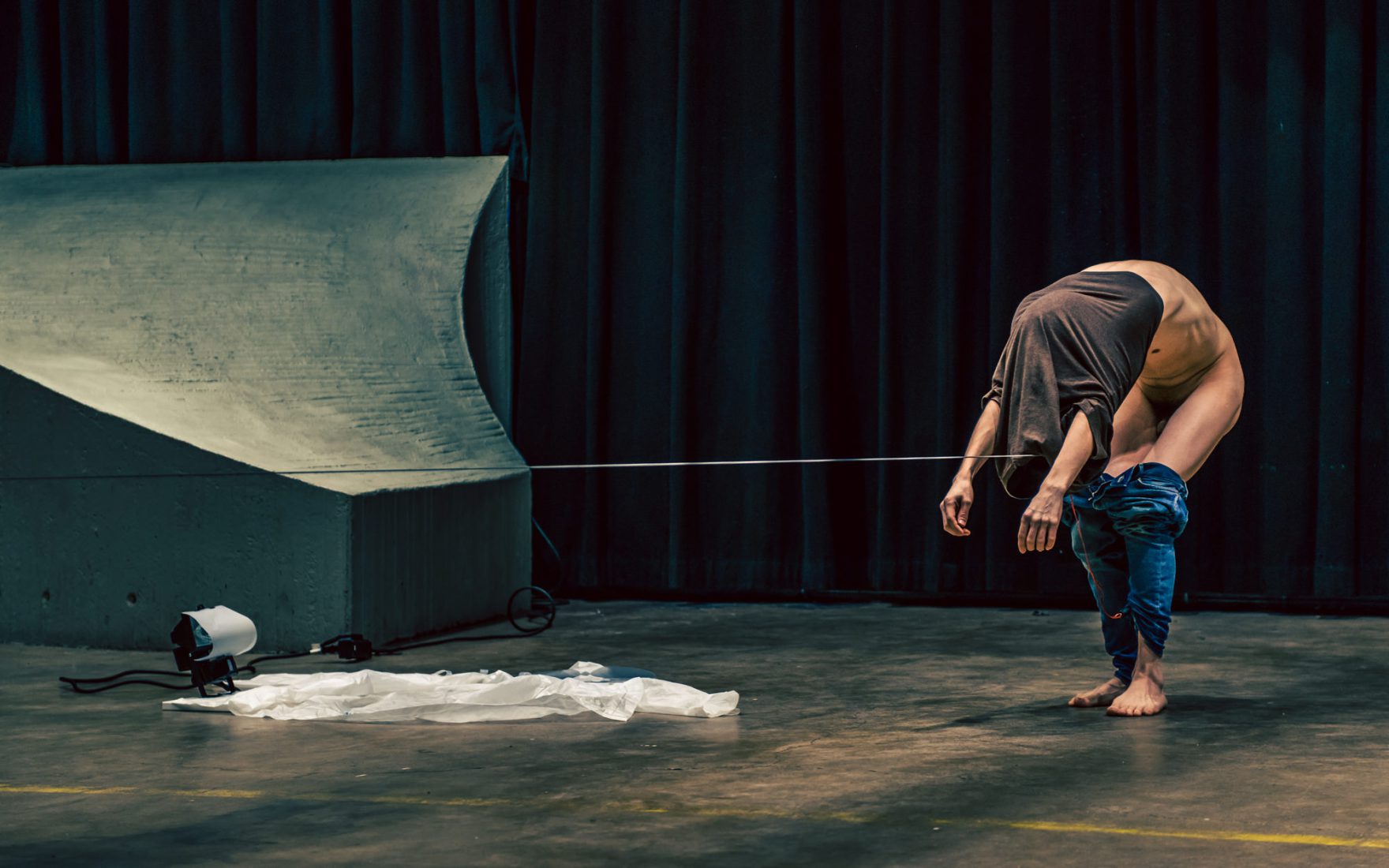
Photo: Saara Autere
Birthday is an assemblage of human and non-human materials, movements and memories that reside in the border between control and freedom. The choreography comes together through a composition of rhythms that the collection of mechanical and natural, organic and synthetic elements produce.
Working group:
Concept, choreography and performance: Mikko Niemistö
Visual design: Anastasia Artemeva
Sound design: Johannes Vartola
Mentor: Maija Hirvanen
Birthday premiered as part of Mad House Helsinki’s 4th season 22th February 2017 at 19.00.
Other performances: 23th and 24th February 2017 at 19.00
---

Photo: Saara Autere
Purettu soolo.
Se syntyy kun yksi kiinnittyy koiran remmiin, joka soittaa kitaraa ja kitara soittaa yhtä.
Se syntyy kun yksi hengittää lampun ”on” ja lamppu hengittää yhden ”off”.
Birthday on tila, jossa erilaiset käyttöesineet, luonnonmateriaalit ja kehomuistot asetetaan vuorovaikutteiseen suhteeseen. Esitys liikkuu tietoisen ja tiedostamattoman, orgaanisen ja synteettisen, rytmiikan ja melun rajamailla, Se on joukko asioita, joiden läpi vaikutteet, muistot ja energiat virtaavat. Se on epäsymmetrinen kokoonpano jonka sisällä yhteydet särisevät, purkautuvat ja ovat jatkuvassa liikkeessä.
Birthdayssa koreografian annetaan olla häilyvä, passiivinen, laiska ja kohiseva, mikäli se niin haluaa.
Mikko Niemistö on helsinkiläinen esitystaiteilija ja koreografi. Hän tutkii ihmiskehoa samaan aikaan syntyvänä ja kuolevana, epästabiilina, hajoavana sekä tilaan ja esineisiin levittäytyvänä. Toimijuuden alkuperä ja häilyvyys, ihmisen ja tilan muodostama ruumis muutoksineen sekä kehon ja erilaisten materiaalien välinen yhteys ovat hänen taiteellisessa työskentelyssään keskeisiä. Hän on kiinnostunut kohinasta, joka voi edustaa yhteyksien häilymistä, toimijoiden ja objektien rajoitusten paljastumista, kommunikaation vaikeutta sekä marginaaliin jätettyä.
Työryhmä:
Konsepti, koreografia ja esiintyjyys: Mikko Niemistö
Visuaalisuus: Anastasia Artemeva
Äänet: Mikko Niemistö ja Johannes Vartola
Mentori: Maija Hirvanen
More info:
https://mikkoniemisto.wordpress.com/portfolio/birthday
http://madhousehelsinki.fi/events/mikko-niemisto-birthday
Cover image: Saara Autere
Entitled
2012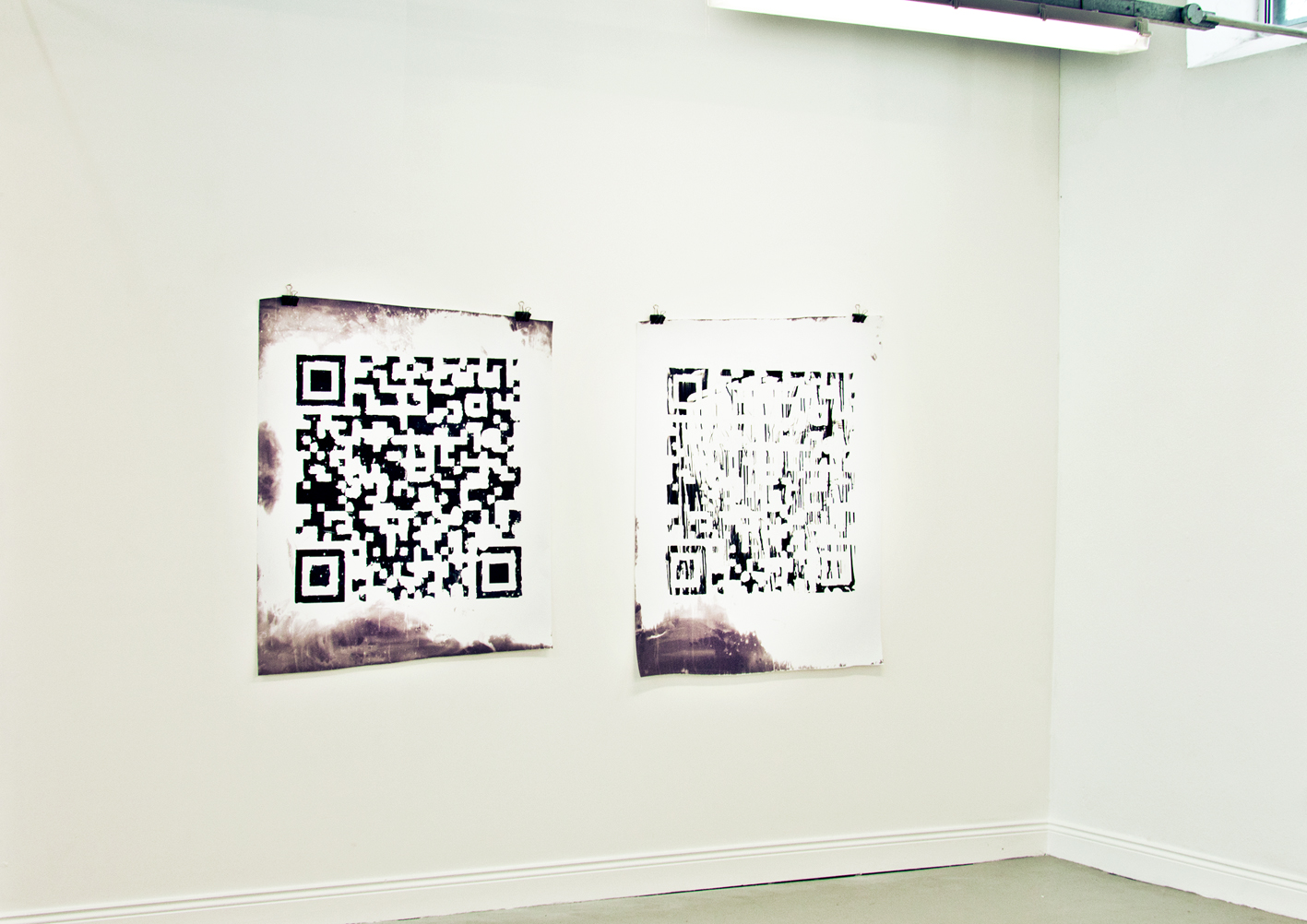
Diptych, Hand printed, Gelatin-Silver print, 130 x 107 cm each
Limerick School of Art and Design Graduate Show, June 2012
This is an interactive artwork where both prints are versions of one image, a computer-generated QR code readable with a digital device. Having been distorted though the manual developing process, one of the prints is scannable while the other one isn’t. Here traditional techniques of the analogue photography are opposed to the recent fascination with interactivity and the physical, cultural and personal restrictions faced in endless choices of today’s world. The piece also intends to challenge the definition of the end product of contemporary art and the multiple possibilities of meaning we are doomed to face when reading an artwork. The concept is influence by the ideas of Kazimir Malevich (1879 – 1935, Russia) who encouraged the abandonment of the representative art form, as well by Peter Weibel (b.1944, Ukraine) who investigates concepts of art, democracy and the global media.
Taking the research in civic-minded street art as well as the science fiction writings of George Orwell and Yevgeny Zamyatin as a starting point, the intention was to apply current communication technology and its vocabulary to the off line space. It is an attempt to insight contemplation of inter-human communication issues and to draw parallels as well as highlight the cause and effect of our preoccupation with the so-called social networking and the substitution of the real with personal electronic communicative devices.
In May 2012 another strand of the project was presented in a art festival called CatDig, curated that year by Lotte Bender in Limerick City.
During the two-day event, things like T- shirts, Hats, Fridge Magnets were given away and also stickers were distributed ,things that frequently made to carry an emblem of a certain team or corporation, things that have no real value but act as advertisement, things that we all like to take for free. Each object carried an image of a QR code, which can be scanned with a smart phone. When scanned, texts such as “This Doesn't Lead Anywhere”, and other phrases to highlight the disappointment of an online detachment would appear on the smart phone screen.
There were also stickers with QR codes placed on the buildings, lampposts and refuse bins on the street.
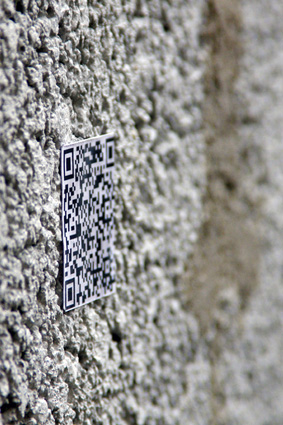 Each item was individually made and possessed a unique code on it, with a unique corresponding sentence. With the intention to distribute as many things as possible, the objects were placed on tables set up in various locations on the street throughout the two days and visibly stated that they were free to take.
Each item was individually made and possessed a unique code on it, with a unique corresponding sentence. With the intention to distribute as many things as possible, the objects were placed on tables set up in various locations on the street throughout the two days and visibly stated that they were free to take.Another strand of the project is a social intervention Vanity Case 2012.
During this project, around 30 handmade labels bearing QR codes were produced, decorated and pinned to clothes in second-hand charity shops in Limerick, which are quite popular amongst the locals, regardless of their income. The idea is that one buys some donated goods and the proceedings go to a specific charity.
When scanned, the codes read
Can you really not afford a brand-new one or does charity make you feel good?
The intention of this piece is to evaluate our relationship with charity shopping, when we get to buy affordable clothing and donate money for charity, kill two birds with one stone so to say. Myself, I’m quite fond of the bargains, even antiques affordable for me due to the ignorance of the volunteer shop assistant. But how good is it really? The artwork questions the mission, the clientele and the necessity of such an establishment.
Do we care what charity it is that we support? Is there any other way to support a charity and lead a sustainable lifestyle? Is it too much to ask? Is it enough? The sentence on the other end of the QR code is quite brutal, but only someone in a possession of quite an expensive mobile device one can read the barcode to see what it says. The juxtaposition of the advances of technology, including the damage the production of the gadgets causes the environment, and the need and the want for charity shops seems absurd.
